Embarking on a food truck venture requires financial planning to ensure sustainability and profitability.
A food truck expense spreadsheet is a helpful tool for tracking food truck costs. It can help owners forecast startup costs, manage ongoing expenses, and maintain a clear overview of their financial health.
Here are our top 4 food truck expense spreadsheets and 1 nifty expense management service that you won't want to miss!
Top free food truck expense spreadsheets
Below are top free templates that can be directly downloaded and tailored for food truck businesses.
1. Google Sheets food truck cost template
This template offers an overview of startup costs as well as ongoing costs, available as a Google Sheets spreadsheet. You can use it to budget for upcoming overhead costs or to figure out how much capital it will take to get your food truck business off the ground. .
Google Sheets' accessibility allows for real-time updates and sharing among team members, which is key for managing finances effectively.

2. Sage's free food truck cost calculator for Excel
Sage provides a downloadable Excel cost calculator tailored for food truck businesses that provides future food truck owners with a cost estimation template.
Two different tabs allow you to input a low estimate and a high estimate, and fields specific to the industry, including permits, equipment, and supplies, making it easier for businesses to predict monthly costs and financial needs.

Download begins as soon as you click the below link:
3. Food Truck Empire's recipe costing template
The recipe costing template by Food Truck Empire is an invaluable tool for menu planning and cost analysis.
Users can calculate costs per recipe and assess the profitability of each menu item. This spreadsheet is not only instrumental in managing food costs but also assists in pricing menu items appropriately.

4. Touch Bistro restaurant expense spreadsheet
This resource by Touch Bistro is designed specifically for the unique needs of the food service industry.
It provides a monthly view and an annual view of recurring expenses, along with a column to track actual vs budgeted expenses.

5. Shoeboxed, an alternative to spreadsheets
Don't want to track expenses manually? We hear you.
While some people thrive on using business expense tracking spreadsheets, others might prefer a more automated method.
If you'd like to forgo manual entry entirely, consider Shoeboxed!
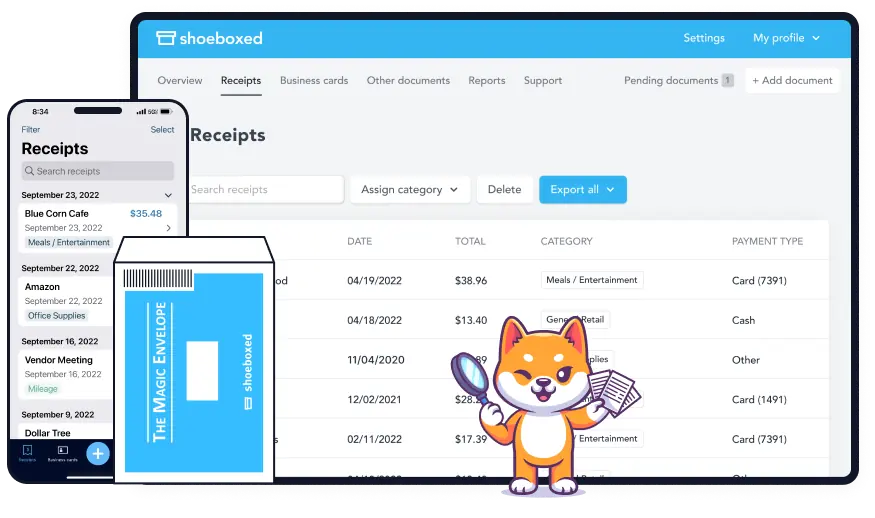
With Shoeboxed's receipt scanner app, simply snap a picture and upload it to your Shoeboxed account, and Shoeboxed's team will extract and verify the expense data from your receipts, assigning the expense one of 15 common tax categories.
For those who want an even easier method for getting receipts in their accounts, Shoeboxed's Magic Envelope service does just that.
Simply stuff your receipts into Shoeboxed's postage-prepaid envelopes and outsource receipt scanning to the pros.
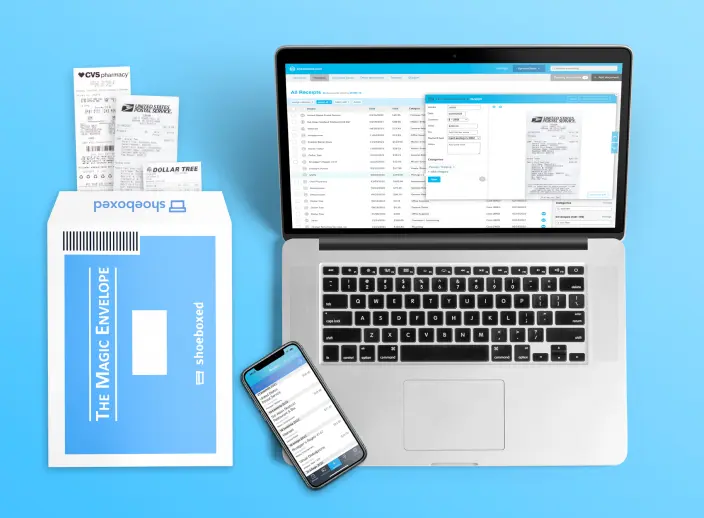
Shoeboxed is the only receipt scanner app that will handle both your paper receipts and your digital receipts—saving customers up to 9.2 hours per week from manual data entry!
Break free from manual data entry ✨
Use Shoeboxed’s Magic Envelope to ship off your receipts and get them back as scanned data in a private, secure cloud-based account. 📁 Try free for 30 days!
Get Started TodayWhat else can Shoeboxed do?
Shoeboxed has been voted as the best receipt scanner app for tax season by Hubspot and given the Trusted Vendor and Quality Choice awards by Crozdesk.
A quick overview of Shoeboxed's award-winning features:
a. Mobile app and web dashboard

Shoeboxed’s mobile app lets you snap photos of paper receipts and upload them to your account right from your phone.
Shoeboxed also has a user-friendly web dashboard to upload receipts or documents from your desktop.
b. Gmail receipt sync feature for capturing e-receipts
Importing e-receipts to your Shoeboxed account is as easy as syncing your Gmail with Shoeboxed, using Shoeboxed's special Gmail Receipt Sync feature.
Shoeboxed’s Gmail Receipt Sync grabs all receipt emails and sends them to your account for automatic processing! These receipts are then labeled as Sent to Shoeboxed in your Gmail inbox.
In short, Shoeboxed pulls the receipt data from your email, including the vendor, purchase date, currency, total, and payment type, and organizes it in your account.
Your purchases will even come with images of the receipts attached!
c. Expense reports
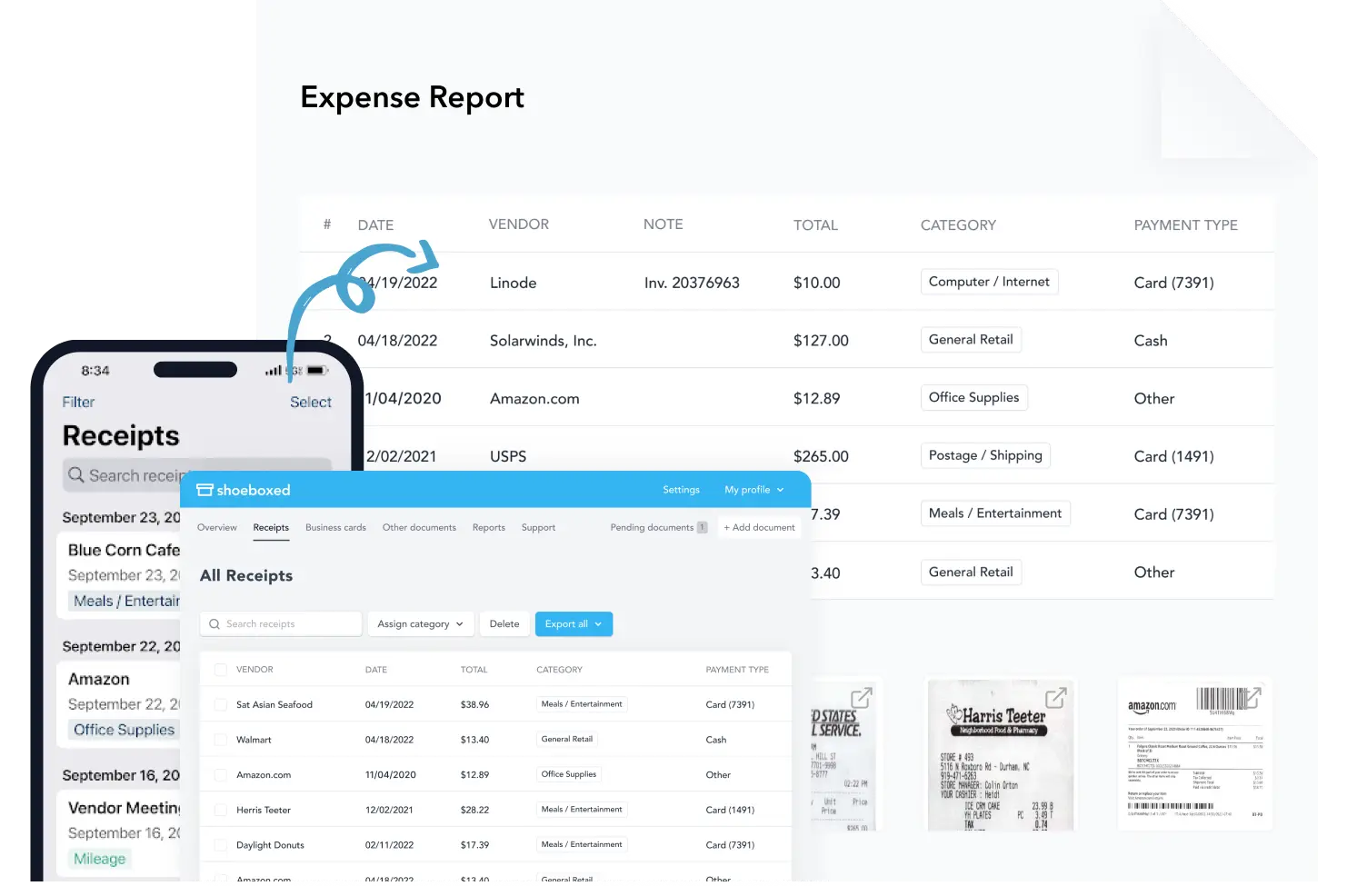
Expense reports let you view all of your expenses in one cohesive document. They also make it simple to share your purchases with your accountant.
Shoeboxed makes it easy to export your yearly expenses into a detailed report. All expenses come with receipts attached.
You can also choose certain types of receipts to include in your expense report. Just select the receipts you want to export and click “export selected.”
d. Search and filter
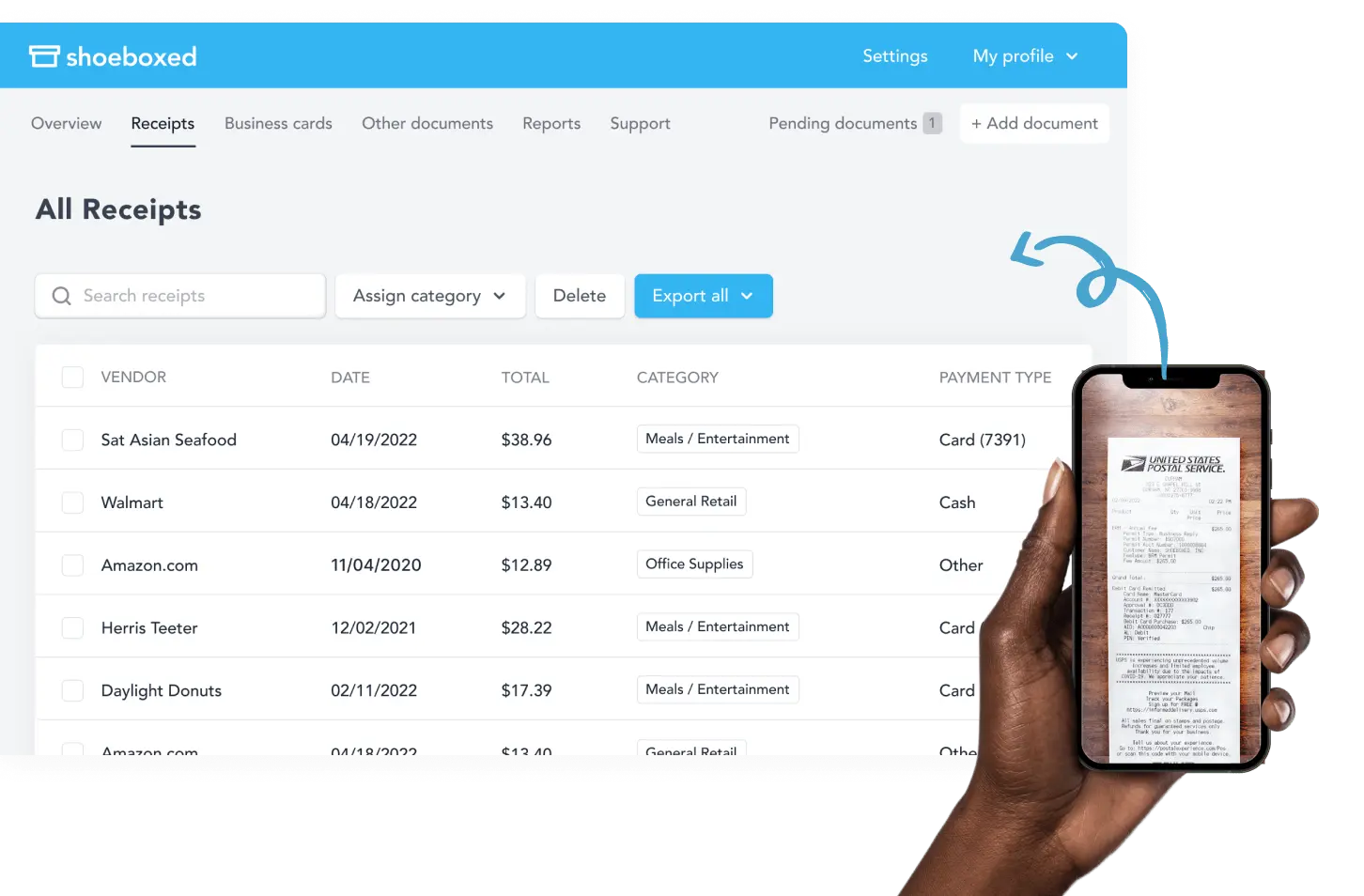
Call up any receipt or warranty in seconds with advanced search features.
Filter receipts based on vendors, date, price, currency, categories, payment type, and more.
e. Accounting software integrations
Export expenses to your accounting software in just a click.
Shoeboxed integrates with 12+ apps to automate the tedious tasks of life, including QuickBooks, Xero, and Wave Accounting.
f. Unlimited number of free sub-users
Add an unlimited number of free sub-users to your account, such as family members, employees, accountants, and tax professionals.
g. Mileage tracker for logging business miles
After you sign up for Shoeboxed, you can start tracking miles in seconds:
Open the Shoeboxed app.
Tap the “Mileage” icon.
Click the “Start Mileage Tracking” button.
And drive!
Whenever you start a trip, Shoeboxed tracks your location and miles and saves your route as you drive.
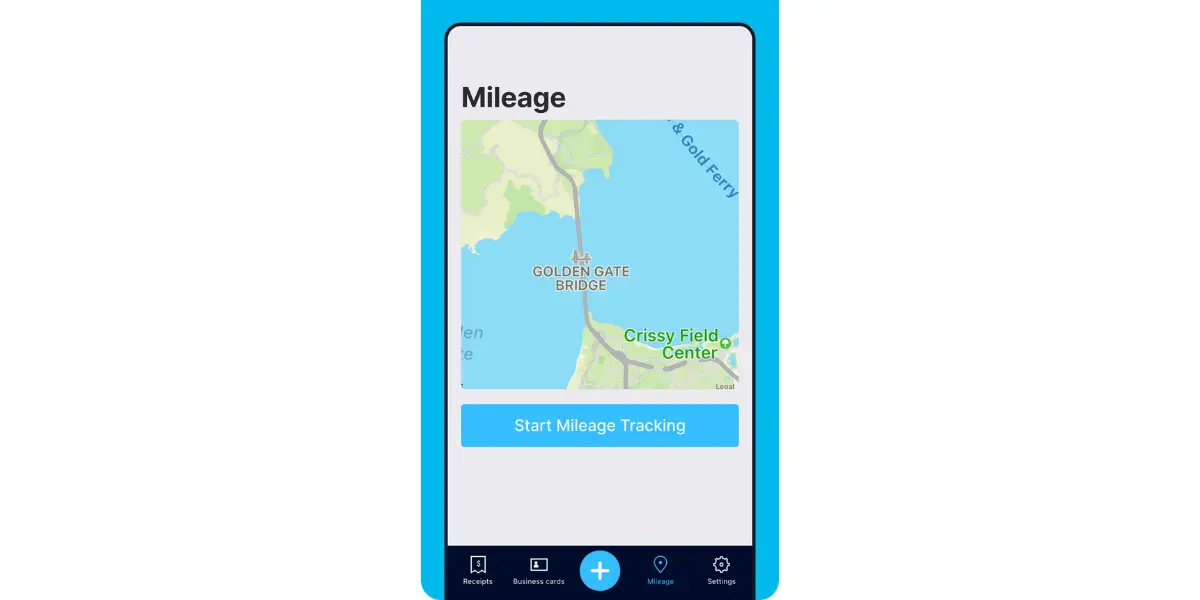
As you make stops at stores and customer locations, you can drop pins to make tracking more precise.
At the end of a drive, you’ll click the “End Mileage Tracking” button to create a summary of your trip. Each summary will include the date, editable mileage and trip name, and your tax deductible and rate info.
Click “Done” to generate a receipt for your drive and get a photo of your route on the map. Shoeboxed will automatically categorize your trip under the mileage category in your account.
g. The Magic Envelope
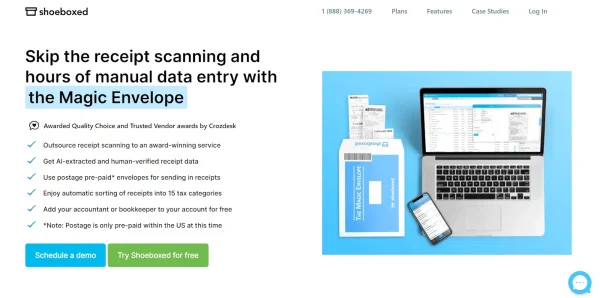
Outsource your receipt scanning with the Magic Envelope!
The Magic Envelope service is Shoeboxed's most popular feature, particularly for businesses, as it lets users outsource their receipt management.
When you sign up for a plan that includes the Magic Envelope, Shoeboxed will mail you a pre-paid envelope for you to send your receipts in.
Once your receipts reach the Shoeboxed facility, they’ll be digitized, human-verified, and tax-categorized in your account.
Have your own filing system?
Shoeboxed will even put your receipts under custom categories. Just separate your receipts with a paper clip and a note explaining how you want them organized!
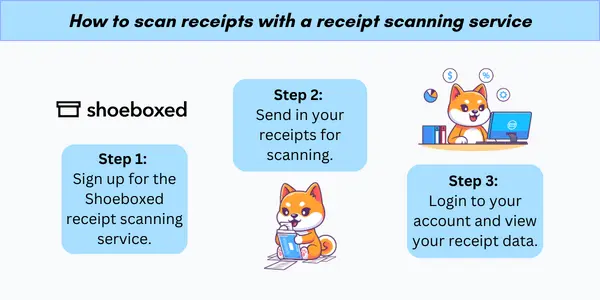
Turn receipts into data for tax time ✨
Try Shoeboxed’s systematic award-winning approach to receipt tracking for tax season. Try free for 30 days!
Get Started TodayAn overview of food truck startup costs
The startup costs associated with launching a mobile food business can be considerable and vary widely depending on the region, the type of food served, and the level of customization of the truck itself.
For most food trucks, these initial expenses include the purchase of the food truck, kitchen equipment, initial inventory, permits, licenses, and insurance.
Entrepreneurs should develop a business plan outlining how they plan to make a profit to estimate the startup and ongoing costs of operating a food truck business.
Beyond the launch phase, food truck owners face fixed expenses such as ingredient costs, fuel, maintenance, employee wages, and various marketing activities.
To manage these effectively, finding an effective way to keep track of costs will be key. A spreadsheet could do the trick if you enjoy a hands-on approach to data entry. Alternatively, for those who know that they will have their hands full with the day-to-day running of the food truck business, you might prefer to outsource expense management to Shoeboxed.
Here are the startup costs to consider for accurate budget planning and financial forecasting.
1. Initial investment
Initial investment encompasses a range of expenses necessary to get the food truck operational. This typically includes the cost of the truck itself, kitchen equipment, initial inventory of food supplies, and any other basic equipment required to start serving customers.
According to a detailed analysis of operation costs, these expenses often amount to $50,000 to $100,000.
Kitchen Equipment: $10,000 - $30,000
Initial Inventory: $1,000 - $2,000
Basic Equipment: $2,000 - $5,000
2. Permit and license fees
Every food truck business must comply with local regulations, including obtaining the necessary permits and licenses. These can vary widely by location, but fees generally include health permits, parking permits, and business licenses.
The costs reflected in a food truck cost breakdown indicate that these legal necessities can run anywhere from a few hundred to several thousand dollars.
Health Permits: $800 - $4,000
Parking Permits: $100 - $1,000 annually
Business Licenses: $50 - $500
3. Vehicle purchase and customization
The core of the business—the food truck—represents a significant portion of the startup costs. Purchasing and customizing a food truck, including the wrap and outfitting with necessary kitchen equipment, ranges from $25,000 to $100,000.
This price fluctuates based on the vehicle's condition, degree of customization, and equipment needs.
It's highlighted through this food truck cost example that a new, fully-equipped truck falls on the higher end of this spectrum, whereas a second-hand truck or less equipment can reduce the cost considerably.
Used Food Truck: $25,000 - $50,000
New Food Truck & Wrap: $50,000 - $100,000
Custom Kitchen Equipment Installation: $10,000 - $30,000
4. Operating expenses
Operating expenses are fundamental to food truck operations, encompassing the continuous costs that keep the truck rolling and serving customers. For example, many food trucks opt to do some of their cooking prep in a commercial kitchen space, which will cost money to lease.
Expenses vary by region but are essential to factor in for a realistic financial plan.
5. Inventory and supplies
Food trucks incur regular costs for food inventory and supplies, which include perishable goods, packaging, and cooking supplies.
According to a food truck cost analysis, inventory management is vital, and costs can potentially influence menu prices and profitability margins.
6. Fuel and maintenance
Fuel is a variable expense that fluctuates with the distance traveled and fuel prices.
Maintenance costs cover vehicle repairs and ensuring kitchen equipment functions correctly.
Timely maintenance avoids larger expenditures down the road and is crucial for safe operations.
7. Insurance
Insurance for food trucks typically comprises liability, vehicle, and property insurance.
Specifics may vary, but comprehensive insurance plans are recommended to protect against accidents, damages, and business interruptions.
8. Employee salaries
Salaries represent a major expense for a food truck. They must be competitive to attract and retain quality staff.
The financial outcomes depend on balancing fair wages with the overall revenue streams of the business.
9. Branding and graphics
Branding and graphics are critical for creating a visually appealing and memorable food truck identity.
Costs in this area cover the design of logos, truck wraps, menus, and promotional materials. Some food truck owners utilize AI image generators of vector graphics to efficiently create and update these elements.
On average, food truck owners spend between $500 and $3,000 on initial branding and periodic updates.
10. Online marketing strategies
For a food truck's online presence, continuous investment in social media marketing, website maintenance, and digital advertising is necessary.
The monthly expenditure on online marketing can span from $0 to $500, with social media platforms often managed by the owners to minimize costs.
Social Media Ads: Depending on the platform and audience reach, costs can be as little as $5 a day to several hundred dollars per month.
Website Maintenance: Hosting fees and content updates may range from $10 to $50 monthly.
11. Local outreach
Local outreach includes participating in community events, local advertising in newspapers, and collaboration with area businesses.
The initiative for local outreach is twofold: to foster community relations and to attract local customers.
One might spend approximately $100 to $1,000 monthly on these activities depending on the extent and frequency of local engagement.
Community Events Sponsorship: $50 - $500 per event
Local Print Advertisements: $50 - $300 per run
Business Partnerships and Cross-Promotions: Variable costs, often negotiable.
Financial management best practices
Effective financial management is crucial for the sustainability of a food truck business. Here are some of the best practices to implement.
1. Stay on top of cash flow analysis
A cash flow analysis is essential in monitoring the inflow and outflow of money.
It helps food truck owners anticipate financial needs and prevent liquidity issues.
For instance, by examining the timing of incoming sales revenue versus outgoing expenses, one can ensure that there is always adequate cash on hand to cover daily operations.
2. Regularly review profit and loss statements
Creating Profit and Loss Statements gives a clearer picture of the business’s financial performance over time.
These financial statements should include sales volume and all sources of revenue and subtract expenses to calculate the net profit or loss.
Food truck owners must regularly review these to understand their financial health and make informed decisions.
3. Employ expense tracking methods
Employing robust expense tracking methods is critical to control costs.
Owners should categorize expenses, such as food supplies, fuel, and maintenance, and compare them to budgeted amounts.
One effective method is using spreadsheets that offer visual data representation, enabling quick identification of cost-saving opportunities.
Frequently asked questions
What expenses should be included in a food truck cost spreadsheet?
A thorough food truck cost spreadsheet covers a variety of expenses. It typically includes initial investment costs like purchasing the food truck and kitchen equipment, as well as recurring costs such as ingredients, fuel, maintenance, salaries, and permits.
How can one estimate the initial investment needed for a food truck?
Initial costs can vary widely, but they often range from $25,000 to $100,000. This includes the vehicle, kitchen equipment, wrapping, and initial inventory. Estimations should also account for local regulations which can affect total cost.
Can food truck spreadsheets provide financial projections?
Yes, some templates offer complex financial models, including projections for profit and loss, cash flow, and more over a span of several years.
What percentage of revenue should be allotted to food expenses?
It's generally recommended that food costs account for 25% to 38% of revenue. Detailed pricing of ingredients for menu items is essential for precise estimations.
Where can one find a comprehensive food truck financial model template?
There are specialized templates available that provide financial performance tools and a dynamic dashboard.
In closing
Whether you use an expense spreadsheet or choose an automated expense management approach like Shoeboxed, a well-managed expense system will pay off by helping food truck owners make decisions by highlighting areas of high expenditure and potential savings.
Tomoko Matsuoka is managing editor for Shoeboxed, MailMate, and other online resource libraries. She covers small business tips, organization hacks, and productivity tools and software.
About Shoeboxed!
Shoeboxed is a receipt scanning service with receipt management software that supports multiple methods for receipt capture: send, scan, upload, forward, and more!
You can stuff your receipts into one of our Magic Envelopes (prepaid postage within the US). Use our receipt tracker + receipt scanner app (iPhone, iPad and Android) to snap a picture while on the go. Auto-import receipts from Gmail. Or forward a receipt to your designated Shoeboxed email address.
Turn your receipts into data and deductibles with our expense reports that include IRS-accepted receipt images.
Join over 1 million businesses scanning & organizing receipts, creating expense reports and more—with Shoeboxed.
Try Shoeboxed today!



